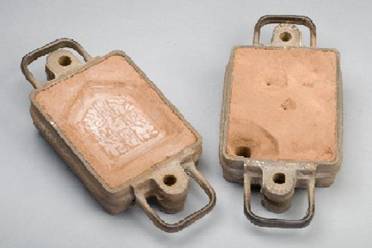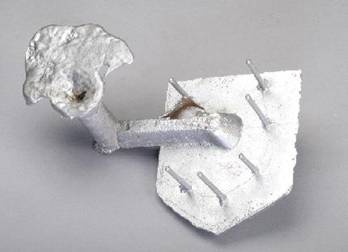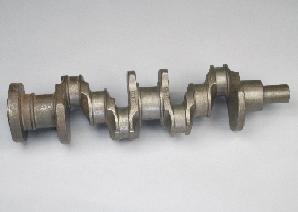Sand casting
Sand castings are formed using compacted sand as the mould, more details of the process can be found in the movie below:
Typical components produced by sand casting are automobile engine blocks and ship propellers.
Advantages:
- Low capital investment means that short production runs are viable.
- Use of sand cores allows fairly complex shapes to be cast.
- Large components can be produced.
Disadvantages:
- The process has a high unit cost, as it is labour intensive and time consuming.
- The sand mould leaves a poor surface finish, which often requires further processing.
- Cannot make thin sections.

The drag (left) and cope (right) of a casting flask

A sand casting with risers and the runner system still attached

A crankshaft for an auto engine which has been produced by sand casting
Different types of sand are used in sand casting;
- Petro-bond – This is a mixture of quality sand and oil or synthetic resin.
- Green sand – A mixture of sand, clay, water and sometimes other additives. It is called green sand because it is re-usable. The right amount of water has to be added to prevent porosity.
- Sand mixed with water glass (NaO.nSiO2.mH2O) can be hardened with CO2 gas through the chemical reaction;
Na2O.nSiO2.(mn + x)H2O + CO2 = Na2CO3.xH2O + n(SiO2.mH2O)
This transforms the sand into a solid mould, which can be used after the cope & drag are removed. - A parting powder similar to talcum powder is put on the pattern to make it easier to remove.
More complicated castings can be made by producing a pattern out of polystyrene foam, which is left in place when the molten metal is added. When the metal is poured into the mould the heat vaporizes the foam a short distance away from the metal surface, allowing the metal to fill the mould cavity.
Permanent Mould casting
The basic process of permanent mould casting is similar to that for sand casting, except that a permanent metallic mould is used. This mould is made of two parts, containing the necessary gates and risers to ensure the correct flow of metal. The metal moulds give a better surface finish than sand casting, and selective cooling rates can give control over the scale and morphology of microstructure formed.

